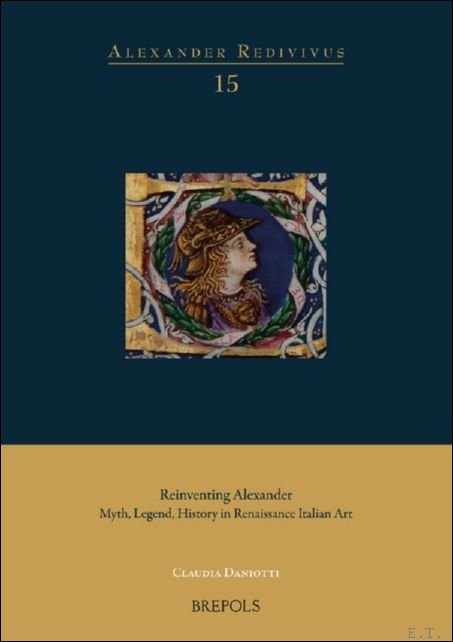Details
Publishers
, Brepols, 2022
Keyword
ikonenkunst, iconograpic, iconograpic, iconograpic
Description
Summary In this book Claudia Daniotti provides the first comprehensive study of the representation of Alexander the Great in Renaissance Italian art, exploring a fundamental turning point in the tradition: the transition from the medieval imagery of Alexander as a legendary, fairy-tale hero to the new historically grounded portrait of him as an example of moral virtue and military prowess. During the Middle Ages, Alexander was turned into a fabled creature and fearless explorer, whose Flight to Heaven and other marvellous adventures were tirelessly recounted and illustrated, enjoying huge popularity. With the humanist recovery of the ancient historical texts and the changing taste and expectations of the wider, wealthier and more diverse public of the courts and cities of the Italian peninsula, the fabulous aura that had surrounded Alexander for centuries evaporated. He was recast as the moral exemplum and valorous military commander spoken of by the newly available ancient historians, and became the protagonist of an unprecedently vast iconographic repertoire established in the course of the sixteenth century. By discussing a body of artworks from 1160s to 1560s spanning several media (from illuminated manuscripts and frescoes to sculptural reliefs, wedding chests and tapestries) and researching this material in constant dialogue with the literary tradition, this book offers a reassessment of the whole visual tradition of Alexander in Renaissance Italy, making sense of a figurative repertoire often perceived as fragmentary and disparate, and casting new light on an overall still neglected chapter in the tradition of the myth of Alexander. TABLE OF CONTENTS Acknowledgments Introduction Chapter 1. The Legendary Tradition of Alexander in Medieval Art and Literature The Medieval Tradition in Italy: An Overview Episodes from the Legend: The Begetting and Birth of Alexander; The Taming of Bucephalus; The Flight with Griffins; The Submarine Voyage; The Visit to the Trees of the Sun and the Moon Chapter 2. The Persistence of the Legendary Tradition in Fifteenth-Century Italian Art Marvellous Adventures in the East in the Doria Tapestries The Flight with Griffins in a Curtius Rufus Manuscript Alexander as King of Swords in the Sola-Busca Tarocchi A Fifteenth-Century Drawing Depicting the Submarine Voyage Alexander among the Nine Worthies: the Sala Baronale in the Castle della Manta; the Triads of Castel Roncolo; the Castelnuovo Cycle; the 'Cavalcavia' with the Worthies of Palazzo Trinci Chapter 3. The Humanist Recovery of Ancient Historical Sources and Its Impact on the Reception of Alexander The Recovery of the Ancient Greek Sources: Plutarch's Life of Alexander; Arrian's Anabasis; Diodorus Siculus's Bibliotheca Historica The Revived Interest in the Ancient Latin Sources: Curtius Rufus's Historiae Alexandri Magni; Justin's Epitoma Historiarum Philippicarum Humanist Use of Ancient Sources: Petrarch; Giovanni Boccaccio; Angelo Decembrio's De politia litteraria; Pier Paolo Vergerio Chapter 4. The Emergence of a New Renaissance Iconography in the Fifteenth Century Alexander on Cassone Panels: The Battle of Issus and the Meeting with the Family of Darius; Two Sienese Panels Based on Plutarch Alexander and the Cycles of Uomini famosi: An Introduction to the Uomini famosi in Italian Art; Representations of Alexander in Uomini famosi Cycles; Medieval Cycles (The Castel Nuovo Cycle, Naples); Transitional Cycles (The Cycle in the Aula Minor, Palazzo Vecchio, Florence; The Cycle in the Orsini Palace of Monte Giordano, Rome); Humanist Cycles (Alexander in the Sala dei Giganti, Padua; The Cycle in the Corte Ducale, Palazzo dell'Arengo, Milan; The 'Piccolomini Cycle' of Famous Men and Women) Images of Alexander in Fifteenth-Century Manuscripts: Images of Alexander Based on Ancient Numismatic Prototypes (Alexander Wearing the Lion-Skin of Hercules; the Helmeted Alexander; Alexander with the Horns of Zeus Ammon); A Curtius Rufus Manuscript ?Illustrated like a Romance Text? Chapter 5. The Development and Consolidation of Renaissance Iconography in the Sixteenth Century Selected Episodes from the Life of Alexander: The Meeting with the Women of Darius; The Marriage of Alexander and Roxane; Alexander, Apelles and Campaspe; The Taming of Bucephalus; The Birth (and Begetting) of Alexander Conclusion Conclusion Appendices Bibliography Index of names List of Illustrations Table of contents

Find out how to use
Find out how to use
